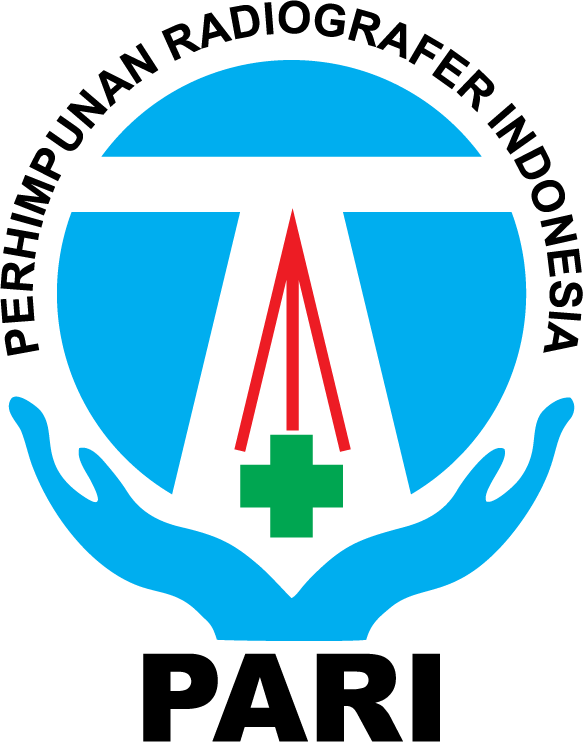Peranan Teknik Compressed Sense (CS) pada Pemeriksaan MRI Lumbosacral dengan Kasus Hernia Nucleus Pulposus (HNP)
Abstract
Background: The number of Lumbosacral MRI examinations at the Radiology Department of the Regional General Hospital of West Nusa Tenggara Province averages 80 patients per month, with the most common case being Hernia Nucleus Pulposus (HNP). The normal duration for each examination is 17-20 minutes. Compressed Sense (CS) was always activated during the author's observation of these examinations, reducing the total scan time for Lumbosacral MRI examinations to 8 minutes. In some MRI cases, there are challenges with non-cooperative patients, such as traumatic cases and being unable to supine position, which causes moving artifacts and makes image results blur, activating the CS technique can solve this problem making examination times faster. The research aims to analyze and describe the technique, the role of the technique, as well as the advantages and disadvantages of the CS technique in Lumbosacral MRI examinations for HNP cases.
Methods: This research is qualitative descriptive research with a case study and literature review approach. use 3 patients, 3 radiographers, dan 3 radiologists, do in March to April 2024. Data was collected by observation, deep interviews, and questionnaires for radiologists about image quality.
Result: Three patients with clinical HNP underwent Lumbosacral MRI examinations without any special preparation. The Lumbosacral MRI protocol includes Survey, Coronal T2W TSE, Sagittal T1W TSE, Sagittal T2W TSE, Sagittal T2W TSE SPIR, Axial T1W TSE, Axial T2W TSE, and MYELO Radial. The protocols use the CS technique with a reduction score of 1.4, except MYEOLO Radial, which can reduce scan time to 7-10 minutes without decreasing image quality. The sequences used serve to provide anatomical information and pathology in the lumbosacral area.
Conclusions: Lumbosacral MRI examinations using the Compressed Sense technique can shorten the examination time without significantly reducing the quality of the images produced, it proved by the questionnaire result. This can increase patient comfort during the examination. The use of reduction values in this CS technique must be considered as it can increase the value of Peripheral Nerve Stimulation (PNS).
Keywords
Full Text:
PDFReferences
Agung, A . Adityawarma, H. Nyoman, I. wayudana, G. (2021). Case Report Herniasi Nucleus Pulposus Lumbal Multiple Disertai Kanal Stenosis Dengan Drop Foot Syndrom dan Atrofi Otot Unilateral. Intisari Sains Medis.
Benzakour, T. Igoumenou, V. Mavrogenis, AF. Benzakour, A. (2019). Current concepts for lumbar disc herniation. Int Orthop.
Bratke, G. Rau, R. Weiss, K. Kabbasch, C. Sircar, K. Morelli, J. et al. (2019). Accelerated MRI of The Lumbar Spine Using Compressed Sensing: Quality And Efeciency. J Magn Reson Imaging.
Brinjikji, W. Luetmer, PH. Comstock, B. Bresnahan, BW. Chen, LE. Deyo, R. et al. (2015). Systematic Literature Review Of Imaging Features of Spinal Degeneration in Asymptomatic Populations. AJNR Am J Neuroradiol.
Chen, S. Fu, P. Wu, H. Pei, M. (2017). Meniscus, Articular Cartilage And Nucleus Pulposus: A Comparative Review of Cartilage-Like Tissues in Anatomy, Development and Function. Cell Tissue.
Davenport, T. Kalakota, R. (2019). The Potential for Artifcial Intelligence in Healthcare. Future Healthc J.
Fardon, DF. Williams, AL. Dohring, EJ. Murtagh, FR. Gabriel Rothman, S. et al. (2014). Lumbar Disc Nomenclature: Version 2.0 Recommendations of the combined task forces of the North American Spine Society, the American Society of Spine Radiology and the American Society of Neuroradiology. In Spine Journal. https://doi.org/10.1016/j.spinee.2014.04.022
Fjeld, OR. Grøvle, L. Helgeland, J. Småstuen, MC. Solberg, TK. Zwart, J. et al. (2019). Complications, reoperations, readmissions, and length of hospital stay in 34 639 surgical cases of lumbar disc herniation. Bone Joint J.
Geethanath, S. Rashmi, R. Amaresha, SK. Shaikh, I. et al. (2013). Compressed sensing MRI: A Review. Critical ReviewsTM in Biomedical Engineering.
JTPD, H. Zhu, L. Yang, K. Makmur, A. DAR, A. Thian, Y. e. al. (2021). Deep Learning Model for Automated Detection and Classifcation of Central Canal, Lateral Recess, and Neural Foraminal Stenosis at Lumbar Spine MRI. Radiology.
Kovacs, FM. Arana, E. Royuela, A. Estremera, A. Amengual, G. Asenjo, B. et al. (2014). Disc Degeneration and Chronic Low Back Pain: An Association Which Becomes Nonsignifcant when Endplate Changes and Disc Contour are Taken into Account. Neuroradiology.
Lebel, R. (2020). Performance Characterization of A Novel Deep Learning-Based MR Image Reconstruction Pipeline. ArXiv. http://arxiv.org/abs/2008.06559.
Lewandrowski, KU. Muraleedharan, N. Eddy, SA. Sobti, V. Reece, BD. Ramírez León, J. et al. (2020). Feasibility of Deep Learning Algorithms for Reporting in Routine Spine Magnetic Resonance Imaging. Int J Spine Surg.
Mahdiyana, H. (2021). Peranan Teknik Compressed Sensing (CS) Pada Pemeriksaan MRI Knee Joint Sekuen 3D Fast Spin Echo (FSE). Repository Poltekes Semarang.
Matcuk, GR. Gross, JS. Fritz, J. (2020). Compressed Sensing MRI Technique and Clinical Applications. Advances in Clinical Radiology. https://doi.org/10.1016/j.yacr.2020.06.008
Meister, R. (2021). Compressed Sense in Pediatric Brain Tumor MR Imaging: Assesment of Image Quality, Examination Time and Energy Release. Springer Link. https://doi.org/10.1007/s00062-021-01112-3
Tsai, JY. Hung, IY. Guo, YL. Jan, YK. Lin, CY. Shih, T. et al. (2021). Lumbar disc herniation automatic detection in magnetic resonance imaging based on deep learning. Front Bioeng Biotech.
Van Putter, C. Regan, J. Russo, A. Seeley, R. Stephens, T. Tate, P. (2017). Seeley’s Anatomy & Physiology (Eleventh). . McGraw Hill Education.
Westbrook. (2014). Handbook of MRI Technique (4th ed.). In Wiley Blackwell.
Yanasak, NE. Kelly, M. (2014). MR Imaging Artifacts And Parallel Imaging Techniques With Calibration Scanning: A New Twist On Old Problems. Radiographics. https://doi.org/10.1148/rg.342135051
Ye, J. (2019). Compressed Sensing MRI: A Review from Signal Processing Perspective. BMC Biomed Eng 1. https://doi.org/10.1186/s42490-019-0006-z
DOI: https://doi.org/10.31983/jimed.v1i1.11806
Article Metrics
Refbacks
- There are currently no refbacks.
JURNAL IMEJING DIAGNOSTIK by http://ejournal.poltekkes-smg.ac.id/ojs/index.php/jimed is licensed under a Creative Commons Attribution-ShareAlike 4.0 International License. Statcounter

.png)
.png)
.png)
.png)
.png)
.png)
.png)











